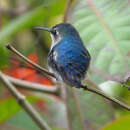en
names in breadcrumbs


Bee Hummingbirds (Mellisuga helenae) are only 5 to 6 cm long and weigh just 1.6 to 1.9 g (a small coin such as a U.S. penny weighs around 2.5 to 3 g). The male Bee Hummingbird is the smallest of all birds and can easily be mistaken for a bee. The male's head and throat are fiery red and he has an iridescent gorget with elongated lateral plumes. The remainder of his upperparts are bluish and the remainder of his underparts are mainly grayish white. The slightly larger female has green upperparts, whitish underparts, an inconspicuous white spot behind the eye and black spot on the lores, and a rounded tail with white tips on the outer tail feathers. The Bee Hummingbird's voice is a prolonged squeaking.
Bee Hummingbirds are endemic to (i.e., found only in) Cuba, where they may occur in woodland, swampland, shrubbery, and gardens, but mainly in coastal forests and forest edges. They occasionally are found in more open areas, but generally require mature growth with thick tangles of lianas (long-stemmed woody vines) and an abundance of epiphytes. They feed on nectar from a range of flowers, as well as on insects. The tiny nest is constructed 3 to 5 m above the ground on a thin twig and is often decorated on the outside with lichens. Construction (by the female alone) takes around 10 days. The two eggs are incubated for around 3 weeks. Hatchlings have a full set of feathers by around 2 weeks and practice flying for several days before leaving the nest at around 18 days.
Bee Hummingbird populations have clearly declined, presumably as a result of reduction in the mature forest habitat they require. Although once widespread on Cuba and the Isle of Pines, they may now survive at only a few localities.
(Bond 1993; Schuchmann 1999 and references therein; Raffaele et al. 2003)